
Petra, originally known to its inhabitants as Raqmu or Raqēmō, is a historic and archaeological city in southern Jordan. It is adjacent to the mountain of Jabal Al-Madbah, in a basin surrounded by mountains forming the eastern flank of the Arabah valley running from the Dead Sea to the Gulf of Aqaba. The area around Petra has been inhabited from as early as 7000 BC, and the Nabataeans might have settled in what would become the capital city of their kingdom as early as the 4th century BC. Archaeological work has only discovered evidence of Nabataean presence dating back to the second century BC, by which time Petra had become their capital. The Nabataeans were nomadic Arabs who invested in Petra's proximity to the incense trade routes by establishing it as a major regional trading hub.

The Fort of São Sebastião lies at the northern end of Stone Town on the Island of Mozambique. It is the oldest complete fort still standing in sub-Saharan Africa. Construction by the Portuguese began in 1558, and it took about fifty years to complete.

Cape Town City Hall is a large Edwardian building in Cape Town city centre which was built in 1905. It is located on the Grand Parade to the west of the Castle and is built from honey-coloured oolitic limestone imported from Bath in England.
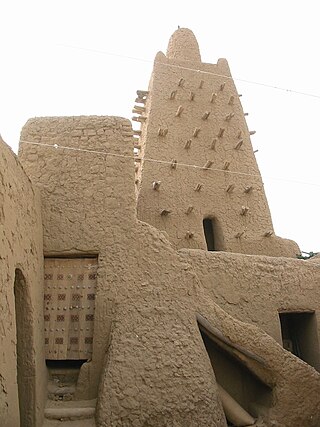
The Djinguereber Mosque in Timbuktu, Mali is a famous learning center of Mali. Built in 1327, and cited as Djingareyber or Djingarey Ber in various languages, its design is accredited to Abu Ishaq Al Sahili who was paid 200 kg of gold by Musa I of Mali, emperor of the Mali Empire. According to Ibn Khaldun, one of the best known sources for 14th century Mali, al-Sahili was given 12,000 mithkals of gold dust for his designing and building of the djinguereber in Timbuktu, but more reasoned analysis suggests that his role, if any, was quite limited. The architectural crafts in Granada had reached their zenith by the fourteenth century, and it is extremely unlikely that a cultured and wealthy poet would have had anything more than a dilettante's knowledge of the intricacies of contemporary architectural practice.
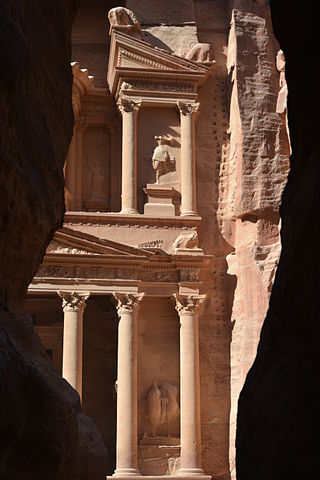
Al-Khazneh, akaKhazneh el-Far'oun, is one of the most elaborate temples in Petra, a city of the Nabatean Kingdom inhabited by the Arabs in ancient times. As with most of the other buildings in this ancient town, including the Monastery, this structure was carved out of a sandstone rock face.

The Siq is the main entrance to the ancient Nabatean city of Petra in southern Jordan. Also known as Siqit, it is a dim, narrow gorge and winds its way approximately 1.2 kilometres and ends at Petra's most elaborate ruin, Al Khazneh. A wide valley outside leading to the Siq is known as the Bab as-Sīq.

Aluka was an online digital library focused on Africa-related material. It focused on globally connecting scholars by building a common platform for online collaboration and knowledge sharing. Aluka's intended audience was higher education and research communities.

A vaṭadāge is a type of Buddhist structure found in Sri Lanka. It also known as a dage, thupagara and a cetiyagara. Although it may have had some Indian influence, it is a structure that is more or less unique to the architecture of ancient Sri Lanka. Vatadages were built around small stupas for their protection, which often enshrined a relic or were built on hallowed ground. Circular in shape, they were commonly built of stone and brick and adorned with elaborate stone carvings. Vatadages may have also had a wooden roof, supported by a number of stone columns arranged in several concentric rows.
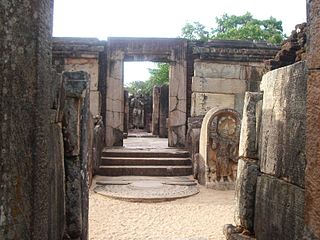
Hatadage is an ancient relic shrine in the city of Polonnaruwa, Sri Lanka. It was built by King Nissanka Malla, and had been used to keep the Relic of the tooth of the Buddha. The Hatadage had been built using stone, brick and wood, although only parts of the brick and stone walls now remain. It appears to have been a two-storey structure, but the upper storey has now been destroyed. Three Buddha statues carved out of granite rock are located within a chamber of the shrine.

Ad Deir, also spelled ad-Dayr and el-Deir, is a monumental building carved out of rock in the ancient Jordanian city of Petra. The Deir was probably carved in the mid-first century AD.

Fort Saint Anthony was a fort built by the Portuguese in 1515 near the town of Axim, in what is now Ghana. In 1642, the Dutch captured the fort and subsequently made it part of the Dutch Gold Coast. The Dutch expanded the fort considerably before they turned it over, with the rest of their colony, to the British in 1872. The fort is now the property of the Ghanaian state and is open to the public.

Fort São Sebastião located in Shama, Ghana, is the third oldest fortification in Ghana. Along with several other castles in Ghana, it was inscribed on the UNESCO World Heritage List in 1979 because of its testimony to the history of European trade, colonization, and exploitation in the region.

Musawwarat es-Sufra, also known as Al-Musawarat Al-Sufra, is a large Meroitic temple complex in modern Sudan, dating back to the early Meroitic period of the 3rd century BC. It is located in a large basin surrounded by low sandstone hills in the western Butana, 180 km northeast of Khartoum, 20 km north of Naqa and approximately 25 km south-east of the Nile. Its MGRS coordinates: 36QWD3477214671. With Meroë and Naqa it is known as the Island of Meroe, and was listed as a UNESCO World Heritage Site in 2011. Constructed in sandstone, the main features of the site include the Great Enclosure, the Lion Temple of Apedemak and the Great Reservoir. Most significant is the number of representations of elephants, suggesting that this animal played an important role at Musawwarat es-Sufra.
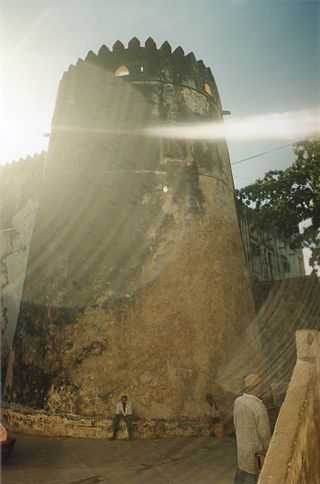
Lamu Fort is a fortress in the town of Lamu in northeastern Kenya. Originally situated on the waterfront, the fort today is located in a central position in the town, about 70 metres (230 ft) from the main jetty on the shore.
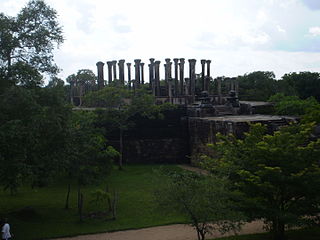
Medirigiriya Vatadageya is a Buddhist structure (Vatadage) in Medirigiriya, Sri Lanka. It was built during the Anuradhapura era.

Little Petra, also known as Siq al-Barid is an archaeological site located north of Petra and the town of Wadi Musa in the Ma'an Governorate of Jordan. Like Petra, it is a Nabataean site, with buildings carved into the walls of the sandstone canyons. As its name suggests, it is much smaller, consisting of three wider open areas connected by a 450-metre (1,480 ft) canyon. It is part of the Petra Archeological Park, though accessed separately, and included in Petra's inscription as a UNESCO World Heritage Site. It is often visited by tourists in conjunction with Petra itself, since it is free and usually less crowded.

Medirigiriya is a town located in Polonnaruwa District in North Central Province, Sri Lanka. The elevation of the town is 61 m (200 ft). The famous archaeological site of Medirigiriya Vatadage is located about 1 km (0.62 mi) from the town centre.

Biete Abba Libanos is an underground rock-cut monolith Orthodox church located in Lalibela, Ethiopia. It was built during the Kingdom of Axum. It is part of UNESCO World Heritage Site at Lalibela.

Biete Maryam is one of the monolithic rock-cut Rock-Hewn Churches, Lalibela of the Ethiopian Orthodox Tewahedo Church. It is part of the UNESCO World Heritage Site at Lalibela.

Biete Meskel is an Orthodox underground monolith church carved into rock. It is located in Lalibela, Ethiopia. The edifice was built during the Kingdom of Axum. It is part of UNESCO World Heritage Site at Lalibela.



















